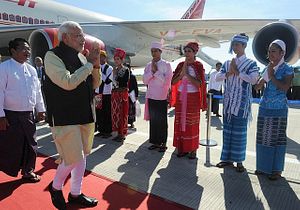Indian foreign policy has changed markedly since the 1990s, driven by realism and its own economic and strategic interests. One important change has been the increased attention New Delhi has been paying to Southeast Asia over the past two decades. The government of P. V. Narasimha Rao, which initiated India’s “Look East Policy,” also recognized the importance of Myanmar and took significant steps to engage its neighbor politically while also strengthening economic ties.
Subsequent governments realized the importance of building on this start. Manmohan Singh became the first Indian prime minister to visit the country in 25 years. During his visit, he made clear India’s intention to engage Myanmar on multiple levels. Singh was accompanied by an Indian business delegation, and a number of announcements were made in areas like information technology and agriculture. But unlike other countries (notably China), New Delhi wanted to drive home the point that it was not attracted only to Myanmar’s natural resources.
Singh’s successor as prime minister, Narendra Modi is placing great importance on relations with Southeast Asia, renaming the national policy “Act East.” Modi himself visited Myanmar in November, and his Commerce Minister Nirmala Sitharaman has also made a recent trip. Sitaraman went in connection with the fifth India-Myanmar Joint Trade Committee meeting, which she co-chaired with Myanmar Union Minister of Commerce U Win Myint. A number of important decisions were taken during the visit, including Indian assistance in upgrading Myanmar’s border points and addressing the bottlenecks that plague sea connectivity between the two countries. The minister also spoke to local businessmen and interacted with local persons of Indian origin (PIOs) to understand some of the problems they face.
While work is already underway to upgrade infrastructure at the existing trade route Moreh-Tamu, the two countries are discussing a trade zone at Behiang, which borders Chin state. The Indian government is also keeping the border states in the loop as was evident from Sitharaman’s visit to Manipur, just a few days before she traveled to Myanmar. In addition to the Northeastern states sharing borders with Myanmar another region that will become important in the context of both trade and connectivity via sea is Chennai. In October 2014, the Shipping Corporation of India launched a bi-weekly service that begins at Chennai and ends at Colombo (following the route Chennai-Krishnapatnam-Yangon-Colombo). The next India-Myanmar Joint Investment Forum is also likely to be held in Chennai. While Northeast India along with Calcutta will benefit immensely from increasing trade via the land route, greater sea connectivity would be a boon for Chennai.
Chennai is the capital of the Indian state Tamil Nadu, which has longstanding links with Myanmar. Members of the entrepreneurial Chettiar community first went to Myanmar in the early 19th century, and be the early 20th century were achieving success as money lenders for agriculturalists. With the advent of the military junta, many Chettiar were forced to leave, but a significant number of PIOs in Myanmar are from Tamil Nadu. India should continue its outreach to this community. In contrast to the considerable attention devoted to the Indian diaspora in other countries, PIOs in Myanmar have hitherto been largely ignored. India should provide them economic assistance to enhance their economic position and ensure that their needs are addressed.
Another test for the government will be its ability to find new ways to work together with other actors. For instance, there has been talk about Japanese investment in an economic zone in Northeast India. There is also scope for a trilateral strategy involving India, Japan and Australia to contribute to the development of Myanmar, not only in the sphere of infrastructure, but also in institution building. This would send the unequivocal message that India’s interest in Myanmar is not driven solely by short-term economic gains.
And of course, a successful Myanmar policy cannot be achieved by the government alone. It is imperative that Indian business exhibit a greater risk appetite.
Most importantly, though, India’s focus in its relations with Myanmar must go beyond economic matters. Building on the progress made by his predecessors, Modi must pursue a multi-pronged vision for bilateral relations.
Tridivesh Singh Maini is a Senior Research Associate with Jindal School of International Affairs, OP Jindal Global University.

































